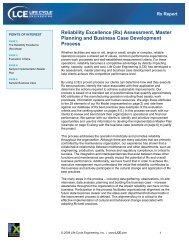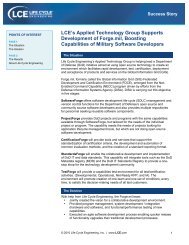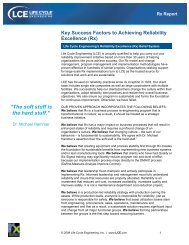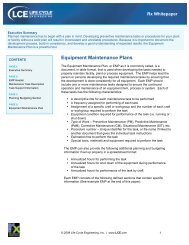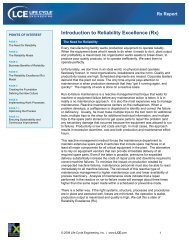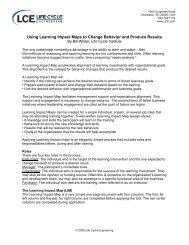Fired Up: Alcoa Smelting Plant Pursues Excellence in Reliability (PDF)
Fired Up: Alcoa Smelting Plant Pursues Excellence in Reliability (PDF)
Fired Up: Alcoa Smelting Plant Pursues Excellence in Reliability (PDF)
You also want an ePaper? Increase the reach of your titles
YUMPU automatically turns print PDFs into web optimized ePapers that Google loves.
RAISING THE BAR<br />
Establish<strong>in</strong>g def<strong>in</strong>itions <strong>in</strong> a variety of<br />
areas have helped trigger improvements. A<br />
primary focus was to def<strong>in</strong>e “what is<br />
possible?” and “what is progress?”<br />
An answer came <strong>in</strong> accept<strong>in</strong>g overall<br />
equipment effectiveness (OEE) as a key<br />
plant-wide metric. OEE tracks sources of<br />
operat<strong>in</strong>g loss, <strong>in</strong>clud<strong>in</strong>g equipment availability,<br />
performance and quality, and is<br />
expressed as a percentage of optimum<br />
performance.<br />
“It’s basically def<strong>in</strong>ed by some past<br />
best performance,” electrode production<br />
manager Tom Svoboda. “You saw it<br />
happen. It wasn’t fictional or hypothetical.<br />
Whether the equipment was runn<strong>in</strong>g<br />
extraord<strong>in</strong>arily that month or you were<br />
really on top of the process, it happened.<br />
The question is, if you did it dur<strong>in</strong>g that<br />
one period of time, why can’t you do it<br />
all the time?”<br />
Us<strong>in</strong>g a sports analogy to illustrate the<br />
importance of 100 percent OEE, if a high<br />
jumper normally jumps 6 feet 6 <strong>in</strong>ches but<br />
establishes a personal best of 7 feet, what<br />
specifically led to this peak 100 percent<br />
performance. Did he tra<strong>in</strong> differently? Did<br />
he change his diet prior to the meet? Did he<br />
wear different shoes? He literally raised the<br />
bar. What can be learned and what can be<br />
done to achieve that mark time and aga<strong>in</strong>?<br />
Ma<strong>in</strong>tenance and operations worked<br />
together to def<strong>in</strong>e peak performance for<br />
plant functions (for example, anode<br />
assembly), processes (ore unload<strong>in</strong>g),<br />
outcomes (scrap) and <strong>in</strong>dividual pieces of<br />
equipment (r<strong>in</strong>g furnace). In compil<strong>in</strong>g this<br />
<strong>in</strong>formation, it was determ<strong>in</strong>ed that $8.3<br />
million <strong>in</strong> annual cost sav<strong>in</strong>gs were possible<br />
as the result of achiev<strong>in</strong>g OEE goals.<br />
With the background <strong>in</strong>formation,<br />
current states were def<strong>in</strong>ed and target<br />
conditions established. Activities – work<br />
projects utiliz<strong>in</strong>g lean manufactur<strong>in</strong>g<br />
tools such as kaizen and Cont<strong>in</strong>uous<br />
Improvement – took place. Progress was<br />
measured and analyzed. And, tangible<br />
benefits were calculated.<br />
In 2004, $2.4 million <strong>in</strong> improvements<br />
were l<strong>in</strong>ked to OEE ga<strong>in</strong>s.<br />
Look<strong>in</strong>g deeper and tak<strong>in</strong>g actions also<br />
led to decreased ma<strong>in</strong>tenance expenses <strong>in</strong><br />
the smelt<strong>in</strong>g plant. In the first year after<br />
beg<strong>in</strong>n<strong>in</strong>g the reliability <strong>in</strong>itiative, expenses<br />
dropped $1.9 million, from a basel<strong>in</strong>e<br />
figure of $32 million to $30.1 million. In<br />
2004, the figure fell another $700,000.<br />
The ratio of ma<strong>in</strong>tenance expenses per<br />
metric ton produced also dropped to $109<br />
<strong>in</strong> 2004.<br />
THE PLAN ON ‘PLANNED’<br />
A major effort also was made to better<br />
def<strong>in</strong>e elements of ma<strong>in</strong>tenance. Specifically,<br />
<strong>in</strong> this operator-led reliability system, “how<br />
does work get planned?” and “how does<br />
work get done?”<br />
“Look<strong>in</strong>g back, we were fool<strong>in</strong>g<br />
ourselves <strong>in</strong>to th<strong>in</strong>k<strong>in</strong>g that we were<br />
healthy,” says ma<strong>in</strong>tenance manager<br />
Danny Reyes. “Many of our old metrics<br />
were out of touch. We thought our<br />
‘percent planned and scheduled work’ was<br />
at 85 percent and our ‘percent PM completion’<br />
was at 90 percent.”<br />
LCE <strong>in</strong>formed the plant that it was us<strong>in</strong>g<br />
the wrong def<strong>in</strong>itions.<br />
“The ‘percent planned and scheduled<br />
work’ was really just ‘percent scheduled.’<br />
Plann<strong>in</strong>g was very limited,” Reyes says. “It<br />
was schedule compliance. Probably 10<br />
percent of those jobs were planned.”<br />
WHAT ARE THE<br />
CHARACTERISTICS OF<br />
A PLANNED JOB?<br />
1) There is an accurate time estimate for<br />
the job such that the supervisor would<br />
have a reasonable expectation on<br />
when he or she could assign the task.<br />
2) There is an accurate estimate of<br />
needed resources <strong>in</strong> terms of crafts<br />
personnel, repair/replacement parts,<br />
tools, support equipment, etc.<br />
3) All necessary <strong>in</strong>formation (bluepr<strong>in</strong>ts,<br />
permits, safety-related, etc.)<br />
is obta<strong>in</strong>ed.<br />
4) Job step sequence, procedures and<br />
<strong>in</strong>structions to accomplish the work<br />
are established.<br />
5) All needed parts and materials are<br />
kitted.<br />
6) As a built-<strong>in</strong> check to assure a quality<br />
planned job, periodically discuss the<br />
nature of the job with a supervisor<br />
and/or the craftsperson assigned to<br />
complete the job. Assure there is a<br />
full understand<strong>in</strong>g of the scope of<br />
work and that the kitted job package<br />
is complete.<br />
A 35-to-1 ratio of crafts personnel (140)<br />
to planners (four) was the crux of the<br />
problem.<br />
“It did not work very well,” says<br />
ma<strong>in</strong>tenance planner Larry McCubb<strong>in</strong>s.<br />
“There was very little time to plan. You<br />
became a scheduler, and not a very good<br />
one at that.”<br />
A reactive environment thrives <strong>in</strong> this<br />
sett<strong>in</strong>g. “We were do<strong>in</strong>g the ‘home ma<strong>in</strong>tenance<br />
approach,’” says Keneipp. “That’s<br />
the way you and I tackle projects on a<br />
Saturday morn<strong>in</strong>g. It’s really unplanned<br />
and <strong>in</strong>efficient.”<br />
The plant has s<strong>in</strong>ce added three planners<br />
for a total of seven, provid<strong>in</strong>g a more<br />
manageable ratio of 20-to-1.<br />
“That makes it possible for these guys to<br />
set up, organize work, plan it, schedule it<br />
out with production centers, make sure all<br />
the parts are there, make sure the equipment<br />
is down and the time is allotted,” says<br />
smelt<strong>in</strong>g ma<strong>in</strong>tenance super<strong>in</strong>tendent<br />
Scott Deon.<br />
Other keys to better plann<strong>in</strong>g:<br />
1)A formal document now outl<strong>in</strong>es the<br />
components of a planned job.<br />
“The poor four planners we had try<strong>in</strong>g to<br />
do everyth<strong>in</strong>g didn’t do th<strong>in</strong>gs the same<br />
way,” says Deon. “This new format now<br />
standardizes how to perform the work.”<br />
2) A formal, secure area is now used by the<br />
planners for job kitt<strong>in</strong>g. In the past,<br />
needed parts and materials were<br />
dispatched piecemeal to a job site. The<br />
pile might sit for weeks until all items<br />
arrived. Dur<strong>in</strong>g the wait<strong>in</strong>g time, it was<br />
not uncommon for parts or tools to be<br />
moved, lost or used for another job.<br />
“As the planner plans the job, he orders<br />
all the materials and has them delivered<br />
here,” says McCubb<strong>in</strong>s. “When everyth<strong>in</strong>g<br />
for the job is here, we gather it on a pallet<br />
or two. The crafts then come and take it<br />
out to the job site and perform the work.”<br />
3) Effective communication.<br />
“I used to th<strong>in</strong>k that I knew what people<br />
wanted. This process taught me that I<br />
didn’t,” says McCubb<strong>in</strong>s. “I didn’t know<br />
what they wanted and what was right for<br />
them. In the past, I planned the job and<br />
didn’t ask questions.”<br />
Adds Deon: “With the shared responsibility<br />
with production, we now know which<br />
job comes first. The person who owns the





